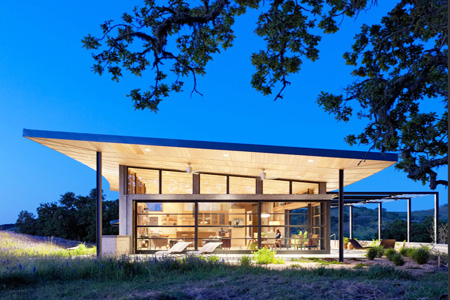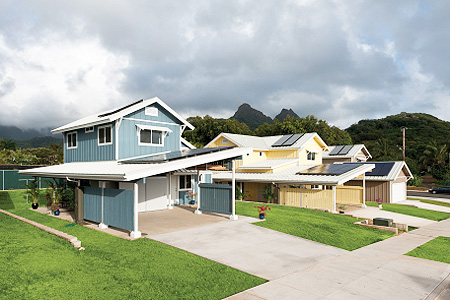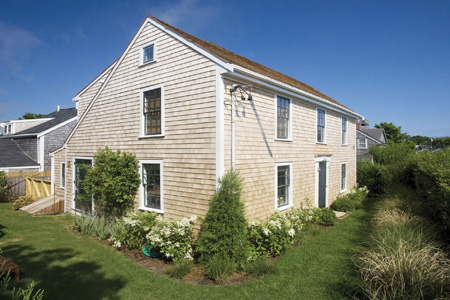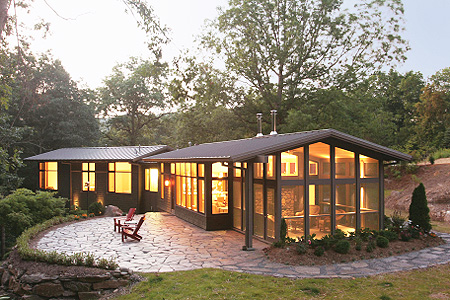EcoHome magazine's 2nd annual design awards chosen such of houses that are not only environmentally exceptional, but look good at the same time.
Award winning green homes have:
- a subdivision of affordable homes in Hawaii;
- a passive-solar home in Carmel, Calif., that's so energy efficient i.e. it has no air conditioning;
- a major remodel of a 260-year-old home on Nantucket Island in Massachusetts that also had to meet architectural-preservation standards.
Here are the five award-winning Eco-friendly homes:01.Project: Caterpillar House | Location: Carmel, Calif.
Architect: Feldman Architecture | Builder: Groza Construction  |
| The Caterpillar House in Carmel, CA | Photo: Joe Fletcher Photography |
The Caterpillar House sits on a bluff in the Santa Lucia Preserve in Carmel, Calif. Its east-west, slightly curved layout maximizes passive solar gain, and additional energy savings come from concrete floors and rammed-earth walls that act as a thermal mass to protect against temperature fluctuations. Overhangs shade the south- and west-facing low-e windows. Ceiling fans and cross-ventilation also work to eliminate the need for air conditioning. A 27,300-gallon rainwater harvesting system supports all site irrigation, and all the plantings are native and drought-tolerant. The house has sustainability-certified cabinetry and reclaimed cork flooring. It has received LEED-Platinum certification.02.Project: Kumuhau Subdivision | Location: Waimanalo, Oahu, Hawaii
Cost: Homes range in price from $225,000 to $325,000; average $121 per square foot
Architect: Armstrong Development | Builder: Armstrong Builders |
| The Kumuhau subdivision on the Hawaiian island of Oahu. | Photo: David Franzen, |
Kumuhau subdivision in Waimanalo on the island of Oahu got praise not only for its green attributes, but also its price tag -- the five floor plans in the 45-home subsidized project cost from $225,000 to $325,000. Contest judges applauded the developers for taking a risk by forgoing air conditioning -- the homes use whole-house fans to exhaust hot air into the vented attics. Each house uses solar panels to supply about two-thirds of their electricity, and the homes are wired to accommodate more solar panels and to charge up an electric car. Rainwater is collected in 51-gallon storage for drip irrigation.03.Project: Nantucket Island home remodel | Location: Nantucket Island, Mass.Cost: $273 per square foot | Architect: Rosenberg Kolb Architects
Builder: Knapp Construction  |
| Nantucket Island remodeled home | Photo: Steve Moore |
It wasn't enough that the owner of a 264-year-old home on Nantucket Island in Massachusetts wanted an addition that was conservation-minded; the house also had to pass muster according to local historic-preservation guidelines. The extensively insulated and sealed 260-square-foot addition included a kitchen, bathroom and entry, and new mechanical and ventilation systems; the project restored the original single-pane window sashes to conserve energy while meeting historical architectural standards.04.Project: GO Home | Location: Belfast, Maine
Cost: $150 per square foot | Architect: GO Logic Homes
Builder: GO Logic Homes  |
| The GO Home in Belfast, Maine | Photo: Trent Bell Photography. |
The GO Home in Belfast, Maine, is 1,300 square feet of near-zero energy use. It's the 12th house in the country to earn the rigorous Passive House designation from the Passive House Institute. Its LEED-Platinum certification is pending. Built with structural insulated panels and passive-solar features, it's expected to save up to $170,000 in energy costs over 30 years -- almost what it cost to build, according to EcoHome.05.Project: Celo Residence | Location: Celo, N.C.
Architect: Samsel Architects, Asheville, N.C. | Builder: Sunspace Homes, Burnsville, N.C. |
| Home in Celo, N.C | Photo: David Dietrich Photography |
The contest judges especially liked the pairing of energy technology with the use of natural materials inside and outside a 1,538-square-foot home in Celo, N.C. The house won praise for tree preservation; rainwater storage for irrigation; pervious walkways, patio and driveway to control water runoff; and the use of drought-resistant plants. The home also features sustainability-certified wood shingles and locally harvested stone. The home's walls are filled with spray-foam insulation and the windows and doors use low-e (low thermal emissivity) argon-filled glass.Special thanks to Mary Umberger.





No comments:
Post a Comment